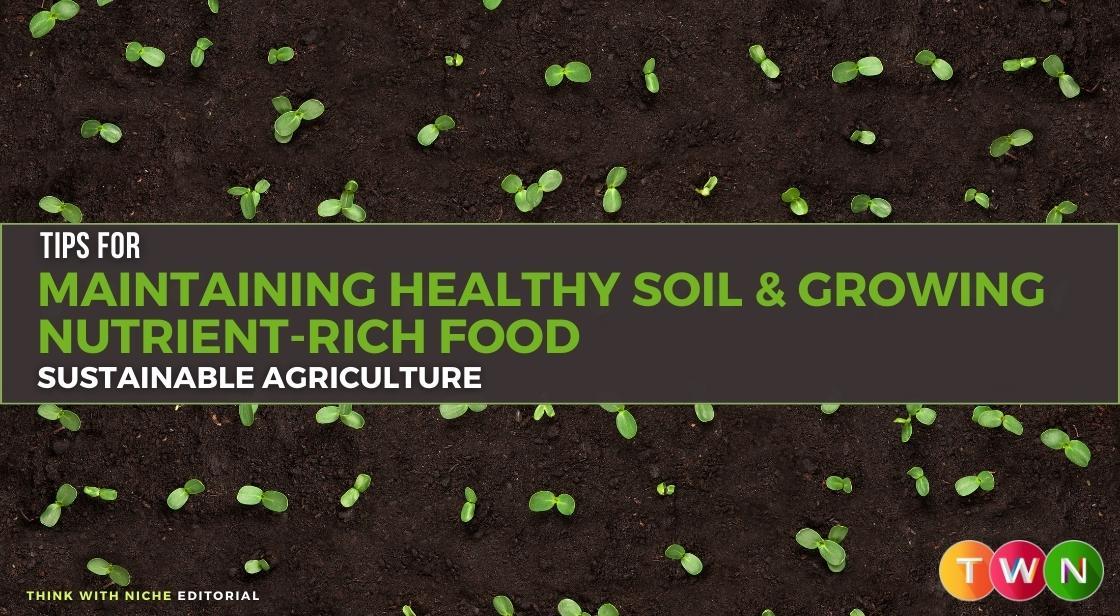Tips for Maintaining Healthy Soil and Growing Nutrient-Rich Food: Sustainable Agriculture

Blog Post
In the quest for vibrant gardens and nutrient-rich produce, there is a powerful ally hidden beneath our feet—healthy soil. The key to cultivating thriving plants and growing food that brims with essential nutrients lies in maintaining a robust soil ecosystem.
This is where sustainable agriculture steps in, offering a pathway to not only bountiful harvests but also the preservation of our planet for future generations.
Whether you have a sprawling backyard or a small plot of land, you can embark on a journey of sustainable agriculture. By adopting practices that prioritize soil health, you can play an active role in growing nutrient-rich food and contributing to a more sustainable future.
This article aims to provide you with invaluable tips on maintaining healthy soil and nurturing crops that are bursting with nutrients. By following these guidelines, you can maximize the potential of your garden and reap the rewards of sustainable agriculture.
Furthermore, we will explore the wide-ranging benefits of this approach, understanding how it supports environmental preservation and fosters a healthier planet.
Get ready to delve into the world of sustainable agriculture, where the health of the soil becomes the cornerstone of abundant harvests and the quality of your food soars to new heights.
With a few simple adjustments and a commitment to sustainable practices, you can cultivate a garden that not only nourishes your body but also contributes to a more sustainable and resilient world.
By embracing sustainable agriculture, we can unlock the ability to produce nourishing food while safeguarding our planet for generations to come. The path to a bountiful harvest begins with nurturing a healthy soil ecosystem—a fundamental aspect of sustainable agriculture.
In this article, we will delve into valuable tips on how to maintain healthy soil and cultivate nutrient-rich food. Additionally, we will explore the myriad benefits of sustainable agriculture and its profound impact on creating a healthier and more sustainable planet.
Imagine biting into a juicy, ripe tomato, bursting with flavor, or crunching on a carrot that's just as sweet as it is crunchy. Now, what if you could grow these in your backyard, and what's more, the nutrient content was through the roof? Well, the secret lies beneath your feet - in the soil.
Healthy soil is the bedrock of a bountiful garden. It's where your food begins its journey, drawing vital nutrients that eventually end up on your plate. But how can you ensure your soil is teeming with everything your plants need?
"Take care of the soil, and the soil will take care of your food."
That's the mantra of sustainable agriculture. It promotes the growth of nutrient-rich food while preserving the environment. But it's not just for large-scale farmers. You too can be a part of this movement, and your backyard garden is the perfect place to start.
Ready to dig in? This article provides tips on how to maintain healthy soil and grow nutrient-rich food. Plus, we'll explore the benefits of sustainable agriculture and how it can contribute to a healthier planet.
Tips for Maintaining Healthy Soil and Growing Nutrient-Rich Food: Sustainable Agriculture
What is Sustainable agriculture?
Sustainable agriculture refers to farming practices that respect the ecological cycles, enhance soil fertility and biodiversity, and promote fair treatment of workers. This approach aims at providing healthy food without damaging the environment or threatening human health. Through sustainable agriculture, we can produce nutrient-rich food while preserving our planet for future generations.
Want a rich harvest? It all starts with the soil. The secret to growing nutrient-packed food is maintaining a healthy soil ecosystem.
This is where sustainable agriculture comes into play. Think of your soil as a bustling city. It's teeming with microscopic organisms, each performing vital roles. They help break down organic matter, control pests, and even improve the soil's structure, making it easier for plants to access water and nutrients.
Nurture this ecosystem, and your plants will thank you with bountiful, nutrient-rich harvests. So, how exactly do you maintain healthy soil? It starts with organic matter.
Compost, cover crops, and organic mulches are your soil's best friends. They feed the soil's microorganisms, improve its structure, and gradually release nutrients that plants need to grow. Similarly, don't be too quick to pull out your till. Tilling can disturb the soil's ecosystem, decreasing its fertility over time. Instead, opt for no-till or reduced-till methods. These practices help maintain the soil's structure, retain moisture, and reduce erosion. Lastly, don't forget to rotate your crops.
Different plants have different nutrient needs and pest profiles. By changing what you plant each season, you help maintain a balance of nutrients in the soil and ward off pests. Remember, the health of our soil mirrors the health of our food. Sustainable agriculture isn't just about growing food today. It's about ensuring we can continue to grow nutrient-rich food for generations to come.
The Importance of Soil Health for Nutrient-Rich Food
Let's start with a simple truth - healthy soil equals healthy food. You can't have nutrient-rich fruits and veggies without first ensuring the ground they grow in is well-nourished. It's a symbiotic relationship that's as old as Mother Nature herself.
So, why is soil health so important? Fantastic question! Soil health directly impacts the amount and diversity of nutrients your food can absorb. Think of it like this: your soil is the kitchen, and your plants are the chefs. Without a well-stocked kitchen (healthy soil), your chefs (plants) can't whip up those nutrient-rich dishes (fruits and veggies) you love.
The Role of Soil Microorganisms
Picture this - billions of microscopic organisms, all working tirelessly to break down organic material and make nutrients available to your plants. Sounds like a science fiction film, right? But it's happening right now, in your garden's soil. These microscopic heroes, known as soil microorganisms, play a pivotal role in maintaining soil health.
From bacteria to fungi, these tiny workhorses work in harmony with your plants, helping them absorb nutrients more efficiently. Without these little guys, your soil would be like a desert - devoid of life and nutritional value.
Practices to Promote Soil Health
Now that you understand the importance and role of soil health, let's talk about how you can improve it. It's easier than you might think! Here are a few sustainable farming methods that can help:
-
Composting: This is like making a multivitamin for your soil. Composting kitchen scraps and yard waste creates a rich organic material full of nutrients your plants will love.
-
Crop Rotation: Planting different crops in the same area over a period helps prevent soil-born diseases, and some plants even add nutrients back into the soil.
-
Cover Cropping: These plants are grown to be plowed back into the soil, improving soil structure and adding organic matter.
Remember, a little love for your soil can lead to a major payoff in the kitchen. Healthy soil produces nutrient-rich food, and that's a win for everyone!
Understanding Soil Composition and pH Levels
Let's dive right into the heart of things - the soil. You see, the soil isn't just a place where plants grow; it's a bustling micro-universe teeming with life and nutrients. Understanding the composition of this world beneath our feet is the first step towards healthier soil and, consequently, nutrient-packed foods.
Also Read: Renewable Energy: A Booming Gateway To Sustainability
Unearthing the Soil's Composition
Think of soil as a layered cake. The topmost layer, humus, is rich in organic matter, playing host to microbes, worms, and insects. Beneath that lies the topsoil, where plant roots and microorganisms live and work. The subsoil is deeper still, and while less active, it provides essential minerals to the layers above. Finally, there's bedrock, the cake's base.
Each of these layers plays a pivotal role in supporting plant life. But the topsoil is, without doubt, the star of the show. It's where plants get most of their nutrients, and it's the place where organic matter decomposes, releasing nutrients back into the soil.
Playing with pH Levels
Just like us, plants prefer their surroundings not too acidic, not too alkaline - somewhere comfortably in the middle. This comfort zone, measured using pH levels, typically lies between 6.0 and 7.0 for most plants. Stick to this range, and you'll be creating a hospitable environment for your plants to thrive.
But don't fret if your soil's pH teeters on the brink. There are many ways to adjust it. For instance, incorporating lime can raise the pH, making it less acidic. Conversely, adding sulfur lowers the pH, making the soil more acidic. Remember, a balanced pH allows optimal nutrient absorption, setting the stage for nutrient-rich food.
Understanding your soil is akin to understanding the needs of your plants. So, put on those gardening gloves, get a little dirty, and start your journey to growing nutrient-packed food today!
Composting:
The Natural Way to Improve Soil comes to maintaining healthy soil, composting is our secret weapon. It's like brewing a nutrient-rich soup for your garden, providing it with all the goodness it needs to flourish. Let's dig into this fantastic natural soil booster and see how it can help us grow nutrient-rich food.
What is Composting?
Composting is the natural process of recycling organic material, such as leaves and vegetable scraps, into a rich soil conditioner. It's an excellent, eco-friendly way to minimize waste while supercharging your soil with essential nutrients. Plus, it's easier than you might think!
The Benefits of Composting
Adding compost to your garden soil not only feeds it with a smorgasbord of essential nutrients but also improves its structure and texture. It helps the soil to retain moisture, thereby ensuring your plants always have a drink on hand. And let's not forget about compost's ability to suppress plant diseases and pests - a natural win-win!
-
Improved Soil Structure: Compost helps break down hard clay soils and bulk up sandy ones, creating a perfect crumbly texture that plants love.
-
Nutrient-rich: Compost is packed with a variety of essential nutrients that plants need to grow strong and healthy.
-
Disease and Pest Control: Compost naturally helps to suppress plant diseases and pests, reducing the need for chemical pesticides.
How to Start Composting?
Ready to get composting? All you really need is a bit of outdoor space, a compost bin, and a mix of green and brown organic materials. Green materials are things like vegetable peels, coffee grounds, and fresh grass clippings. Brown materials include dried leaves, straw, and wood chips. Mix these together in your compost bin and let nature do the rest!
In a nutshell, composting is a sustainable, wallet-friendly, and highly effective way of maintaining healthy soil. So why not give it a shot?
Your garden will thank you, and so will the environment. Happy composting!Try it out and watch as your plants flourish in the nutrient-rich soil that your compost provides. After all, a healthy garden begins with healthy soil. Happy gardening!
Cover Crops:
The Secret to Healthy Soil and High Yield Crops maintaining healthy soil and growing nutrient-rich food, maybe we should turn that phrase on its head. Because, believe it or not, cover crops are a gardener's best friend, the secret weapon for a thriving, bountiful harvest.
Cover crops, also known as "green manure," are plants grown primarily to manage soil erosion, soil fertility, soil quality, water, weeds, pests, diseases, biodiversity, and wildlife in an agroecosystem—an ecological system managed by humans. They're nature's way of replenishing the soil with essential nutrients, preventing erosion, and keeping pesky weeds at bay.
But how, you ask? It's all in the roots. Cover crops have a unique ability to reach deep into the soil, breaking up hardpan, improving soil structure, and drawing up nutrients that would otherwise remain inaccessible to other plants. It's a natural, sustainable process that's been nurturing our earth for centuries.
Choosing the Right Cover Crop
When it comes to choosing the right cover crop, the options can seem endless. There are legumes like peas and beans, grasses like oats and rye, and even brassicas like radishes and mustards. The key is to choose a cover crop that suits your specific soil needs and climate conditions.
From Soil Health to Table: The Benefits of Cover Crops
But the benefits of cover crops extend far beyond the soil. These hard-working plants are often edible, adding a nutritious boost to your dinner table. Plus, their flowers provide a habitat for beneficial insects, promoting a balanced ecosystem in your backyard, farm, or garden.
The Takeaway: Cover Crops for Sustainable Agriculture
So there you have it, folks. Cover crops are the unsung heroes of sustainable agriculture, helping us maintain healthy, nutrient-rich soil. They're a win for our gardens, a win for our bodies, and a win for our planet. So next time you're planning your garden or farm, don't forget the cover!
Watering Techniques for Maintaining Soil Health little water goes a long way"? Well, in the world of soil health, this idiom couldn't be more true. Water is like liquid gold for soil, but it's all about balance.
Overwatering can lead to waterlogged soil and root rot, while underwatering can leave your soil and plants parched. The trick? It's called smart watering, and it could be the key to maintaining your soil health and growing nutrient-rich food.
1. The 'Check-and-Balance' Technique
Don't just water your soil on a set schedule. Instead, get up close and personal with it. Feel it with your fingers. If the top 1-2 inches of soil are dry, it's time to water. If it's still damp, hold off. It's a simple check-and-balance technique that keeps your soil from being too wet or too dry.
2. Deep Watering
Give your plants a long, slow drink. Deep watering encourages your plants to grow deep roots, making them more resilient and capable of reaching nutrients further down. To do this, water slowly until you see it start to puddle, then stop. Wait for the water to soak in, then repeat. It might take a bit longer, but your soil and plants
will thank you. Remember, patience is a garden's best friend. You're not just watering the plants, you're nurturing life.
3. Feed Your Soil, Feed Your Plants
Just as we need a balanced diet to thrive, so does your soil. Nutrient deficiencies can lead to less productive plants and poor-quality produce. To avoid this, enrich your soil with organic matter like compost or manure.
These natural fertilizers work wonders for the soil's health. They increase nutrient content, enhance soil structure, and promote beneficial soil microbes. It's a triple win!
4. Rotate Your Crops
Ever heard of crop rotation? It's an old-school method that's still gold. Rotating your crops helps prevent soil depletion and disrupts pest and disease cycles. This means healthier soil and healthier plants.
Simply put, don't plant the same crop in the same place every year. Switch it up. Your soil will appreciate the variety, and you'll benefit from a more nutritious harvest.
5. Embrace Sustainable Agriculture
Sustainable agriculture is all about nurturing the soil and preserving its fertility for future generations. It emphasizes reducing chemical inputs, conserving water, and promoting biodiversity.
By adopting these practices, you're not just boosting your garden's productivity. You're also contributing to a more sustainable and resilient food system. Now, that's what we call a green thumb!
Integrating Crop Rotation for Nutrient- Dense Produce
Ever heard of crop rotation? This age-old farming method is more than just a fancy term. It's a secret sauce to growing foods that are teeming with nutrients. But what is it exactly, you ask?
Crop rotation is the practice of growing different types of crops in the same area across different seasons. This method helps replenish the soil's nutrients that certain crops can deplete, making it a natural fertilizer of sorts. It's like giving the soil a well-deserved vacation!
So, how can integrating crop rotation help you cultivate nutrient-dense produce? Let's take a look:
-
Preserving soil fertility: Different crops have varying nutrient demands. By rotating crops, you ensure that the soil isn't exhausted of its nutrients. Refueled and revitalized, the soil then becomes a fertile bed for your produce to thrive and soak in these nutrients.
-
Balancing soil organisms: Crop rotation encourages the growth of beneficial soil organisms and keeps the harmful ones in check. These tiny little creatures play a vital role in making nutrients available to your crops.
-
Preventing soil erosion: Crop rotation helps maintain soil structure and organic matter, preventing erosion. A healthy soil structure enables better root growth and nutrient uptake.
So, the next time you're planning your garden or farm, remember to mix things up a little. Your soil will thank you, and so will your nutrient-packed harvest!
The Benefits of Sustainable Agriculture:
Ever wondered about the magic that unfolds beneath our feet in the world of soil and seeds? The way we treat this precious resource dictates the quality of the food we grow and how sustainably we can continue farming. Welcome to the fascinating realm of sustainable agriculture!
1. The Power of Sustainability
Imagine a world where farming enhances our environment, instead of depleting it. That's the promise of sustainable agriculture. It's a method of farming that respects the earth, reduces soil erosion, increases biodiversity, and produces food brimming with nutrients. The goal? To create a system that can be maintained indefinitely.
2. Nourishment from the Ground Up
Your food is as healthy as the soil it grows in. In sustainable practices, farmers enrich the soil naturally. They use organic matter, like compost, to boost soil fertility instead of relying on synthetic fertilizers. The result? Crops that are bursting with flavor and packed with nutrients.
3. The Cycle of Life: A Wonder to Behold
Sustainable agriculture is all about embracing the natural cycle of life. Farmers invite beneficial insects and birds into their fields to control pests, and they rotate crops to prevent disease and maintain soil health. It's a holistic approach, aiming to work with nature, not against it.
So, how can we apply these principles in our own gardens and farms? Stay tuned for our top tips on maintaining healthy soil and growing nutrient-rich food. Together, we can be the change and create a more sustainable future.
1. Maintain Soil Health
First and foremost, it's essential to keep your soil healthy and vibrant. How you ask? By nurturing it with organic matter, of course! This can be in the form of compost, worm castings, or green manure crops.
2. Rotate Your Crops
Next on the agenda is good ol' crop rotation. This tried-and-true practice keeps soil nutrient levels balanced, preventing any single nutrient from being depleted. It's a bit like a gym routine for your garden: change things up to keep the soil energetic and strong.
3. Grow Nutrient-Rich Foods
Finally, let's talk food. Not just any food, but nutrient-rich crops. Choose plants like leafy greens, legumes, and root vegetables. These hard-working heroes not only nourish us but also contribute to the soil's wellbeing, creating a beautiful cycle of life and health.
There you have it, folks! Armed with these tips, you're ready to become a steward of the soil and a green-thumb guru. Let's do our part to make this world a little bit greener, and a lot healthier.
Organic vs. Conventional Agriculture: Which is Better for Soil Health?
Pop quiz time, folks! What's better for soil health: organic or conventional agriculture? This is one of those hot topics that sparks lively debates among farmers, gardeners, and food lovers alike. Let's dive into the dirty details, shall we?
On one hand, conventional agriculture often provides higher yields, thanks to synthetic fertilizers and pesticides. They act like a rocket fuel for crops, pushing them to grow faster and bigger. But, like anything on steroids, there are some not-so-great side effects.
Conventional Agriculture: A Double-Edged Sword
Conventional farming methods can lead to nutrient depletion and soil erosion. That's like taking all the goodness out of your favorite chocolate chip cookie and leaving you with a bland, crumbly mess. Not so appetizing, right?
The synthetic fertilizers and pesticides used in conventional farming can also contaminate our precious water resources, posing risks to wildlife and even our own health. Think about that the next time you're enjoying a glass of water.
A Thumbs Up for Organic Agriculture
On the flip side, organic agriculture is like the slow food movement for the soil. Organic farming methods nourish the soil, improve its structure and water-holding capacity, and increase biodiversity. They're like a yoga class for your garden, bringing balance and harmony.
Yes, organic farming might produce lower yields in the short term. But, in the long run, it builds healthier, more resilient soil that can better withstand pests, diseases, and the impacts of climate change. So, it's a case of the tortoise versus the hare, and we all know how that story ends.
And the Winner is...
When it comes to soil health, organic agriculture takes the crown. It's a more sustainable approach that respects Mother Nature and invests in the long-term vitality of our ecosystems. So, whether you're a gardener, a farmer, or a foodie, remember: healthy soil grows nutrient-rich food. And that's a win for everyone!
Reducing Pesticide Use: A Sustainable Approach to Agriculture
Let's talk dirt - literally! If you're looking to grow nutrient-rich food, your soil's health is the starting point. What if I told you that by reducing pesticide use, you could take a more sustainable approach to agriculture, benefiting not only your soil but also your produce? Sounds like a win-win, doesn't it?
Understanding Pesticides and Their Impact
First things first, what are pesticides? They are substances used to eliminate pests and diseases that threaten the crop. But here's the catch: while they handle the bad guys, they can also harm the good guys - the beneficial organisms that contribute to soil health and fertility. Not ideal, right?
Excessive use of pesticides can lead to soil degradation, reducing its ability to retain water and nutrients. This means your soil might not be in its prime shape for growing nutrient-rich food. Alarm bells ringing yet?
The Power of Organic Farming
Enter organic farming, the hero we didn't know we needed. This method involves natural processes and substances, avoiding synthetic chemicals like pesticides.
The result? A healthy, balanced soil ecosystem teeming with life. Think earthworms, microorganisms, and the likes. Yes, they are your new best friends!
Organic farming promotes biodiversity, improves soil structure and fertility, and enhances nutrient cycling. But that's not all. It also reduces pollution and helps combat climate change. Talk about multi-tasking!
Practical Tips for Reducing Pesticide Use
-
Plant diversity: Growing different types of crops can prevent the spread of pests and diseases. Variety is indeed the spice of life!
-
Companion planting: Some plants naturally repel certain pests. So, why not let them do the job instead of resorting to chemicals?
-
Natural pesticides: If you must use pesticides, opt for natural ones. They're less harmful to the soil and non-target organisms.
-
Soil testing: Regular soil testing can help detect nutrient imbalances and prevent over-fertilization. Knowledge is power!
So, there you have it. Reducing pesticide use isn't just a sustainable approach to agriculture; it's also a route to maintaining healthy soil and growing nutrient-rich food. It's time we give our soil the love and respect it deserves, don't you think?
Protecting Soil Health from Erosion and Compaction
Kicking off our dirt dialogue, let's tackle two culprits of soil health decline: erosion and compaction. These soil saboteurs can sneak in and strip your soil of its vitality, leaving your plants hungry and weak. But don't worry, we've got some tips to keep your soil strong and vibrant.
Erosion: The Soil's Silent Enemy
Erosion is a sneaky thief, washing away your soil's precious nutrients with every rainfall. This process leaves your plants nutrient-deprived and your food is less nutritious. But, you can combat erosion with a bit of strategy and some hard work.
-
Mulching: Mulching isn't just for sprucing up your garden visually. It provides a protective barrier, helping to keep your soil in place during heavy rain.
-
Planting Cover Crops: Don't leave your soil bare! Planting cover crops can help hold the soil together and prevent nutrient loss.
-
Building Terraces: If you're dealing with sloping land, terraces can slow down water runoff and reduce erosion.
Compaction: The Soil's Unseen Oppressor
Compaction, on the other hand, squishes your soil, making it tough for roots to dig deep and access key nutrients. This can lead to stunted plant growth and a less bountiful harvest. But, there are ways to loosen things up!
-
Regular Tilling: This helps to aerate the soil, making it easier for roots to penetrate and access nutrients.
-
Avoid Overwatering: Too much water can cause the soil to compact. Carefully monitor your watering habits to avoid this.
-
Use of Organic Matter: Adding organic matter such as compost or manure can improve soil structure and prevent compaction.
By taking these measures to protect against erosion and compaction, you're well on your way to maintaining a healthy soil and growing nutrient-rich food. Remember, your soil is the foundation of your garden. Treat it with care and it will reward you with an abundant and nutritious harvest.
The Role of Microorganisms in Soil Health and Plant Nutrition
Imagine a bustling city, alive with activity, where every resident has a vital role to play. No, we're not referring to New York or Tokyo, but to the incredibly rich ecosystem beneath our feet - the soil!
This bustling metropolis is teeming with microorganisms, all busy performing tasks essential to soil health and plant nutrition.
Microorganisms: The Unsung Heroes
It's easy to overlook these microscopic powerhouses, but they're the unsung heroes of agriculture. Microorganisms, including bacteria, fungi, and protozoa, help break down organic matter, releasing essential nutrients into the soil.
These nutrients are then absorbed by plants, providing them with the sustenance they need to grow and thrive.
"Think of microorganisms as the soil's personal chefs," says Dr. Soil, a leading expert in soil health. "They take raw materials - dead plants and animals - and cook them down into a nutritious smorgasbord for plants."
Microorganisms also promote soil structure, which helps retain water and nutrients, and prevent erosion. In other words, they're the glue that holds the soil ecosystem together. But how do we promote these beneficial microbes?
Nurturing Your Soil's Microbiome
Just like us, microorganisms need food, water, and a comfortable living environment. Organic matter, such as compost or green manure, provides a smorgasbord for microbes. Regular watering - but not overwatering - is essential, as most soil organisms are aquatic.
It's also important to minimize soil disturbance. Tilling, for example, can disrupt microbial communities and lead to soil erosion. Instead, consider practices like crop rotation and cover cropping, which protect and nourish the soil.
Remember: Healthy soil is teeming with life. By nurturing your soil's microbiome, you're laying the groundwork for a productive, nutrient-rich garden or farm. So, here's to the unseen heroes beneath our feet - the microorganisms that keep our soil healthy and our plants nourished.
Indian government initiatives for Sustainable Agriculture
Pradhan Mantri Krishi Sinchai Yojana (PMKSY): This scheme aims to improve irrigation facilities in the country. It provides financial assistance for the construction of new irrigation canals, the renovation of existing canals, and the installation of water pumps.
Pradhan Mantri Fasal Bima Yojana (PMFBY): This scheme provides crop insurance to farmers against losses due to natural calamities. Farmers can insure their crops against hail, flood, drought, and other natural disasters.
Paramparagat Krishi Vikas Yojana (PKVY): This scheme aims to promote traditional and organic farming methods. It provides financial assistance to farmers for adopting organic farming practices, such as using bio-fertilizers and bio-pesticides.
National Mission for Sustainable Agriculture (NMSA): This mission aims to promote sustainable agriculture practices throughout the country. It focuses on areas such as water conservation, soil health management, and crop diversification.
National Food Security Mission (NFSM): This mission aims to increase food production and productivity in the country. It focuses on crops such as rice, wheat, pulses, and oilseeds.
Important facts
- Healthy soil contains a diverse range of microorganisms that help to break down organic matter and release nutrients.
- Crop rotation can help to maintain soil health by reducing the build-up of pests and diseases.
- Cover crops can help to prevent soil erosion and improve soil structure.
- Composting can help to add organic matter to soil and improve soil fertility.
- Sustainable agriculture practices can help to reduce soil degradation and improve long-term soil health.
- Soil pH can affect nutrient availability to plants.
- Excessive use of synthetic fertilizers can lead to soil degradation and nutrient loss.
- Soil erosion is responsible for an estimated $37.6 billion in economic losses annually in the US.
- The world has lost a third of its arable land due to erosion or pollution in the past 40 years.
- In the US, 85% of topsoil has been lost due to human activity.
- Organic farming can increase soil organic matter by 15-20% over conventional farming methods.
- Sustainable agriculture can increase crop yields by 79%.
- Soil degradation affects 33% of the world's land, reducing the soil's ability to provide essential ecosystem services.
- The global population is expected to reach 9.7 billion by 2050, increasing the demand for food by 70%.
- In the US, 90% of cropland is managed using conventional farming methods that rely on synthetic fertilizers and pesticides.
- Sustainable agriculture practices can reduce greenhouse gas emissions by up to 50%.
- Healthy soil can sequester up to 10% of global carbon emissions annually.
You May Like
EDITOR’S CHOICE












